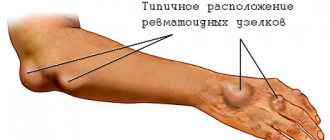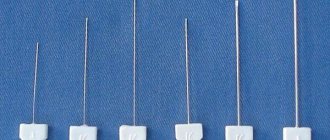The terms “rheumatic fever” and “rheumatism” are actually synonymous. This is a disease that occurs due to a disruption of the immune system as a result of a sore throat or scarlet fever - infections caused by group A β-hemolytic streptococcus.
Our expert in this field:
Serebryansky Yuri Evstafievich
Cardiologist, geriatrician, therapist, professor, Honored Doctor of the Russian Federation, Doctor of Medical Sciences
Call the doctor Reviews about the doctor
Rheumatic fever can occur at any age; young people are most often affected. Currently, in developed countries, due to the competent use of antibiotics, the prevalence of rheumatism has fallen. But in some parts of the planet it is growing, for example, in India, in some states of the USA. The disease remains a big social problem in Russia. Its most serious complication is heart valve defects, which are formed as a result of inflammation in its inner lining - the endocardium.
Why does rheumatic fever occur?
Group A β-hemolytic streptococcus is a bacterium that can cleverly deceive the immune system. It secretes toxins that closely resemble substances found in human connective tissue. The immune system begins to get confused: it attacks not only harmful streptococci, but also its own organs. First of all, the heart, joints, skin, kidneys, and nervous system are affected.
If treatment for tonsillitis or scarlet fever is started on time and completed, the risks of rheumatic fever are minimal. If streptococcal infections occur frequently, and full treatment is not carried out, unpleasant symptoms of rheumatic fever may occur after about 2 weeks.
Prevention of ARF
Primary is timely diagnosis and treatment of GABHS pharyngitis.
Secondary - prevention of new episodes of GABHS infection, including eradication of GABHS even in asymptomatic carriers.
The duration of antibiotic prophylaxis is determined based on the characteristics of the existing pathological process. If we are talking about post-streptococcal arthritis, it can be limited to 1-2 years. In case of ARF without carditis, the duration of taking antibiotics is 5 years or until the patient is 21 years old (whichever is longer), ARF with carditis without consequences is 10 years or up to 21 years old (whichever is longer), ARF with damage to the heart valves is 10 years or up to 40 years old ( whichever is longer), and sometimes for life.
How does rheumatic fever manifest? In what cases should you consult a doctor?
Rheumatic fever manifests itself differently in different people. Some have few symptoms and are mild, while others have a very rapid onset of the disease. Sometimes rheumatism occurs latently: there are no symptoms, tests do not reveal any abnormalities, and years after suffering a sore throat, a person is diagnosed with a heart defect.
One of the manifestations of rheumatic fever is actually the fever itself, that is, rises in temperature, fever, chills. Many people are bothered by chest pain and increased fatigue - these are manifestations of rheumatic carditis, inflammation in the muscles of the heart and the inner lining lining its chambers and valves.
In some patients, rheumatic fever “licks” the joints, usually large ones (most often the knees). They become swollen, red, hot to the touch, and painful. These symptoms are temporary and do not lead to permanent joint deformation. Therefore, doctors have long said: “rheumatism licks the joints, but bites the heart.”
A rash may appear on the skin in the form of painless rings, slightly raised above the skin (this symptom is called ring-shaped erythema), or small painless nodules.
If the disease “licks” the nervous system, it manifests itself in the form of violent movements in different parts of the body and behavioral disturbances.
There are other manifestations, but they are less common.
When should you see a doctor? The best time is as soon as you get a sore throat (typical symptoms: sore throat, fever, difficulty swallowing). Adequate treatment must be carried out immediately. If, after 2–4 weeks, the temperature rises again, pain in the joints and chest begins to bother you, or a rash appears on the skin, run to a rheumatologist.
We will call you back
Message sent!
expect a call, we will contact you shortly
Publications in the media
Acute rheumatic fever (ARF) is a systemic inflammatory disease of connective tissue involving the heart and joints in the pathological process, initiated by group A β-hemolytic streptococcus, occurring in genetically predisposed people. The term rheumatism, widely used in practice, is currently used to designate a pathological condition that combines acute rheumatic fever and rheumatic heart disease.
Statistical data . Incidence: 2.1 per 100,000 population in 2001. The incidence of rheumatic heart disease in Russia is 0.17%. The predominant age is 8–15 years. Etiology. -Hemolytic streptococcus of group A, “rheumatogenic” serotypes M3, M5, M18, M24. The M protein on the streptococcal membrane has antigenic determinants similar to components of the heart muscle, brain and synovial membranes.
Genetic aspects . Ag D8/17 B-lymphocytes are detected in 75% of patients with ARF. Pathogenesis • Antistreptococcal antibodies are responsible for selective damage to the heart valves and myocardium with the development of immune aseptic inflammation, cross-reacting with heart tissue (molecular mimicry) • M-protein has the properties of a “superantigen” that causes activation of T- and B-lymphocytes without preliminary processing of Ag- presenting cells and interactions with class II molecules of the major histocompatibility complex.
Clinical picture • Onset of the disease. In more than half of the cases, 2–4 weeks after a streptococcal nasopharyngeal infection, fever, asymmetric joint pain, pain in the heart, shortness of breath, and palpitations occur. In other patients, the onset occurs as a monosyndrome (carditis, arthritis or chorea) • A repeated attack occurs with symptoms of carditis.
• Arthralgia and rheumatic polyarthritis (80% of patients) - typical reactive synovitis with fluid effusion into the joint cavity, swelling and redness of the periarticular tissues, sometimes with severe pain, tenderness and limitation of active and passive movements. Characteristic features:
•• damage to large joints (knee [most often], ankle, elbow, shoulder and much less often - wrist) •• symmetry of the lesion •• migrating, volatile nature of arthritis •• complete reversibility of the articular syndrome, no changes on radiographs, restoration of joint function • • in children, signs of arthritis, as a rule, completely disappear, and in adults a persistent course can be observed, leading to the development of Jaccoud's syndrome (painless deformation of the hands with ulnar deviation without inflammation in the joints and without dysfunction of the joint) •• with rheumatism, more often with repeated attacks, polyarthralgia rather than arthritis often occurs.
• Fever (90%). • Subcutaneous nodules (10% of patients), grain to pea-sized, localized in the periarticular tissues may appear during acute rheumatic fever. These nodules do not bother patients, they are painless, and the skin over them is not changed. Involution of the nodules occurs over a period of several days to several weeks. Observed only in children.
• Ring-shaped erythema - pale pinkish-red spots up to 5-7 cm in diameter with clear, not always smooth edges. Characterized by localization on the skin of the chest, abdomen, back and limbs, spontaneous disappearance and (rarely) recurrence. Occurs in less than 5% of patients. Erythema nodosum is not typical for rheumatism. • Chorea occurs in 10–15% of patients, more often in girls, 1–2 months after a streptococcal infection. It is chaotic involuntary twitching of the limbs and facial muscles. Characteristic is the complete disappearance of symptoms during sleep. • Rheumatic carditis (rheumatic carditis) can be primary (first attack) and recurrent (repeated attacks), with or without the formation of valve disease. Clinical symptoms of rheumatic carditis: •• Cardialgia . Characterized by prolonged stabbing, aching pain in the heart area, usually without irradiation. With pericarditis, pain is associated with breathing and intensifies in a horizontal position. •• In most cases an enlarged heart , which is not always detected physically. A chest x-ray is recommended. •• Arrhythmias as a manifestation of myocarditis ••• Sinus tachycardia (100 or more per minute), recorded at rest ••• Atrial fibrillation occurs, as a rule, when signs of mitral valve stenosis appear ••• Ventricular (rare) or supraventricular extrasystoles •• • Atrioventricular block with prolongation of the P-Q interval over 0.2 s or the appearance of Wenckebach (Samoilov-Wenckebach) periods. •• Decrease in sonority of the first tone at the apex of the heart, appearance of the third tone and murmurs. A gentle blowing systolic murmur with a tendency to increase in intensity and conducted into the axillary region is a symptom of mitral valvulitis. Protodiastolic murmur along the left sternal border is a sign of aortic valvulitis. •• Signs of congestive heart failure are rarely observed with primary rheumatic carditis; much more often they accompany recurrent rheumatic carditis. • Acute rheumatic fever lasts 6–12 weeks. There is no chronic or continuously relapsing course.
Laboratory data • Increased ESR, increased titers of antistreptolysin O, AT to DNase in a titer of more than 1:250 • Bacteriological examination of a throat smear reveals group A -hemolytic streptococcus. Instrumental data • ECG • Chest X-ray • EchoCG. Differential diagnosis • Reactive arthritis • Lyme disease • Infective endocarditis • Viral (Coxsackie B) myocarditis • Mitral valve prolapse • Functional heart murmur. Kissel-Jones-Nesterov diagnostic criteria (revised 1992) • Major criteria: •• carditis •• polyarthritis •• chorea •• annular erythema •• subcutaneous nodules • Minor criteria: •• clinical symptoms (fever, joint pain) • • laboratory changes (increased ESR, appearance of CRP, prolongation of the P–Q interval •• Additional signs: positive cultures from the tonsils for group A β-hemolytic streptococcus, increased titers of antistreptolysin-O and/or other antistreptococcal antibodies. The presence of two large or one large and two minor criteria in combination with the mandatory presence of additional signs allows us to consider the diagnosis of acute rheumatic fever reliable.Despite the presence of time-tested criteria, the diagnosis of ARF continues to be a problem, since individual criteria (fever, ESR, etc.) are not specific, and subcutaneous nodules and Annular erythema is rarely observed.
TREATMENT Management tactics . For acute rheumatic fever, hospitalization, bed rest, and a diet low in salt and rich in vitamins and protein are indicated. The basis of drug treatment is antibacterial and anti-inflammatory therapy. Drug treatment • Antibacterial therapy •• Benzylpenicillin 1.5–4 million units/day for adolescents and 400–600,000 units/day for children for 10–14 days, followed by a transition to benzathine benzylpenicillin or benzathine benzylpenicillin + benzylpenicillin procaine •• When if you are allergic to penicillins, you should choose a macrolide: roxithromycin for children 5–8 mg/kg/day, adults 150 mg 2 times/day, clarithromycin for children 7.5 mg/kg/day, adults 250 mg 2 times/day. It should be remembered that streptococcal resistance to erythromycin is currently increasing. • NSAIDs for 3.5–4 months (during treatment it is necessary to periodically conduct blood tests, urine tests, and liver function tests) •• Diclofenac 50 mg 3 times a day. • The use of GC is most justified for pancarditis. One of the treatment regimens is prednisolone 20–30 mg/day until clinical effect, then gradually reducing the dose over 20–30 days.
Prevention • Primary prevention : rational treatment of streptococcal diseases of the oropharynx for 10 days •• Aminopenicillins ••• amoxicillin 750 mg/day for children, 1500 mg/day for adults •• Cephalosporins ••• cephalexin for children with body weight <40 kg - 25– 50 mg/kg/day, adults 250–500 mg 2–4 times/day (daily dose 1–2 g) ••• cefaclor children 20 mg/kg 3 times/day, adults 750 mg 3 times/day ••• cefuroxime for children 125–250 mg 2 times a day, adults 0.25–0.5 g 2 times a day •• Macrolides ••• roxithromycin for children 5–8 mg/kg/day, adults 150 mg 2 times a day days •• Penicillins with β-lactamase inhibitors ••• amoxicillin + clavulanic acid (adults 375 mg 3 times / day) for 10 days. • Secondary prevention is indicated for patients who have had acute rheumatic fever to prevent relapses. The best results are achieved by year-round bicillin prophylaxis (benzathine benzylpenicillin 600,000–1,200,000 units (children), 2,400,000 units (adults) once every 3 weeks. Benzathine benzylpenicillin + benzylpenicillin procaine 1,500,000 units once every 10–12 days. D duration of secondary prophylaxis •• at least 5 years after the last reliable rheumatic attack for patients who have had acute rheumatic fever without carditis •• more than 5 years - for patients who have had rheumatic carditis •• with relapses for life • Prevention of infective endocarditis against the background of formed rheumatic heart disease with carrying out any surgical interventions (tooth extraction, abortion, abdominal surgery) - see Infectious endocarditis.
Synonym . Sokolsky-Buyo disease. Abbreviations. ARF - acute rheumatic fever.
ICD-10 • I00 Rheumatic fever without mention of cardiac involvement • I01 Rheumatic fever with cardiac involvement
Modern methods of treatment
For rheumatic fever, antibiotics are prescribed; to combat inflammation, non-steroidal anti-inflammatory drugs (NSAIDs: for example, naproxen or aspirin) or more powerful drugs (hormonal drugs - corticosteroids, immunosuppressants).
If the disease is in the active phase, the doctor may refer you for hospitalization in a hospital. Subsequently, the patient is observed and treated by a rheumatologist in the clinic. Rehabilitation is carried out in cardiological sanatoriums.
Over time, rheumatic fever can cause heart disease, arrhythmia, and heart failure. If you have suspicious symptoms, visit your doctor and get tested. Make an appointment by phone: +7 (495) 230-00-01
The material was prepared by a cardiologist, geriatrician, therapist, professor, Honored Doctor of the Russian Federation, Doctor of Medical Sciences at the international clinic Medica24 Yuri Evstafievich Serebryansky.
Epidemiology of ARF
Acute rheumatic fever and rheumatic heart disease are called diseases of poverty and economic disadvantage. Complications caused by GABHS are the leading cause of death from cardiovascular disease in people under 50 years of age living in developing countries. ARF can occur at any age.
Worldwide, there are approximately 470,000 new cases of ARF and 275,000 deaths associated with rheumatic heart disease each year.
Most often, ARF occurs in children aged 5 to 15 years. ARF develops in 0.5-3% of cases if GABHS pharyngitis is not treated.
How is ARF treated at the Rassvet Clinic?
We provide timely diagnosis and adequate treatment of GABHS pharyngitis, which reduces the incidence of ARF by almost 70%. When choosing antibacterial therapy, we always give preference to penicillin antibiotics - as the most effective drugs that have been proven to reduce the incidence of ARF. We never reduce the course of antibiotic therapy when there is clinical improvement. If GABHS pharyngitis is detected, we do not prescribe local treatment (rinses, sprays) to the detriment of systemic antibacterial therapy.
We provide adequate eradication therapy for GABHS in ARF in order to prevent relapses and progression of rheumatic heart disease. We offer a full examination for diagnosed ARF - ECG, ECHO-CG, consultation with a cardiologist and neurologist with the selection of the necessary therapy.
Author:
Chekaldina Elena Vladimirovna otorhinolaryngologist, Ph.D.







